Last Updated on May 22, 2022
Crystal is a general-purpose, concurrent, multi-paradigm, object-oriented programming language.
With syntax heavily inspired by the language Ruby, it is a compiled language with built-in static type-checking, but specifying the types of variables or method arguments is generally unneeded. This adds the benefit of a shallower learning curve.
The language also offers a powerful macro system, the compiler automatically checks for null references in compile time, a sleek concurrency model that uses green threads, as well as dedicated syntax to easily call native libraries.
Crystal is published under the Apache License 2.0.
Here’s our recommended books to learn Crystal.
1. Crystal For Rubyists by Serdar Dogruyol
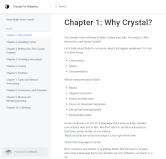 This books starts with a brief introduction about the merits of Crystal.
This books starts with a brief introduction about the merits of Crystal.
It proceeds to explain how to install Crystal before moving on to helping the reader write their first Crystal program.
The reader then explores how to create a new project, testing, FizzBuzz, types and method overloading. The last couple of chapters cover macros and metaprogramming and C bindings.
2. Language Reference (Official Documentation)
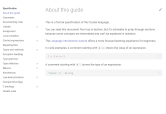 This is a formal specification of the Crystal language. It’s advisable to jump through sections because some concepts are interrelated and can’t be explained in isolation.
This is a formal specification of the Crystal language. It’s advisable to jump through sections because some concepts are interrelated and can’t be explained in isolation.
3. Compiler Manual (Official Documentation)
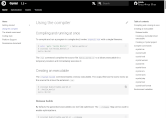 This documentation provides essential and concise information.
This documentation provides essential and concise information.
The manual shows you how to compile code written in Crystal.
4. Standard Library API (Official Documentation)
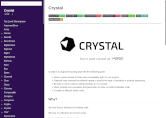 Crystal is a programming language with the following goals:
Crystal is a programming language with the following goals:
- Have a syntax similar to Ruby (but compatibility with it is not a goal)
- Statically type-checked but without having to specify the type of variables or method arguments.
- Be able to call C code by writing bindings to it in Crystal.
- Have compile-time evaluation and generation of code, to avoid boilerplate code.
- Compile to efficient native code.Read the book
5. Shards Manual (Official Documentation)
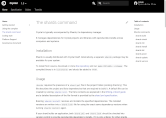 Crystal is typically accompanied by Shards, its dependency manager.
Crystal is typically accompanied by Shards, its dependency manager.
It manages dependencies for Crystal projects and libraries with reproducible installs across computers and systems.
Shards is usually distributed with Crystal itself. Alternatively, a separate shards package may be available for your system.
All books in this series:
| Free Programming Books | |
|---|---|
| Ada | ALGOL-like programming language, extended from Pascal and other languages |
| Agda | Dependently typed functional language based on intuitionistic Type Theory |
| Arduino | Inexpensive, flexible, open source microcontroller platform |
| Assembly | As close to writing machine code without writing in pure hexadecimal |
| Awk | Versatile language designed for pattern scanning and processing language |
| Bash | Shell and command language; popular both as a shell and a scripting language |
| BASIC | Beginner’s All-purpose Symbolic Instruction Code |
| C | General-purpose, procedural, portable, high-level language |
| C++ | General-purpose, portable, free-form, multi-paradigm language |
| C# | Combines the power and flexibility of C++ with the simplicity of Visual Basic |
| Clojure | Dialect of the Lisp programming language |
| ClojureScript | Compiler for Clojure that targets JavaScript |
| COBOL | Common Business-Oriented Language |
| CoffeeScript | Transcompiles into JavaScript inspired by Ruby, Python and Haskell |
| Coq | Dependently typed language similar to Agda, Idris, F* and others |
| Crystal | General-purpose, concurrent, multi-paradigm, object-oriented language |
| CSS | CSS (Cascading Style Sheets) specifies a web page’s appearance |
| D | General-purpose systems programming language with a C-like syntax |
| Dart | Client-optimized language for fast apps on multiple platforms |
| Dylan | Multi-paradigm language supporting functional and object-oriented coding |
| ECMAScript | Best known as the language embedded in web browsers |
| Eiffel | Object-oriented language designed by Bertrand Meyer |
| Elixir | Relatively new functional language running on the Erlang virtual machine |
| Erlang | General-purpose, concurrent, declarative, functional language |
| F# | Uses functional, imperative, and object-oriented programming methods |
| Factor | Dynamic stack-based programming language |
| Forth | Imperative stack-based programming language |
| Fortran | The first high-level language, using the first compiler |
| Go | Compiled, statically typed programming language |
| Groovy | Powerful, optionally typed and dynamic language |
| Haskell | Standardized, general-purpose, polymorphically, statically typed language |
| HTML | HyperText Markup Language |
| Icon | Wide variety of features for processing and presenting symbolic data |
| J | Array programming language based primarily on APL |
| Java | General-purpose, concurrent, class-based, object-oriented, high-level language |
| JavaScript | Interpreted, prototype-based, scripting language |
| Julia | High-level, high-performance language for technical computing |
| Kotlin | More modern version of Java |
| LabVIEW | Designed to enable domain experts to build power systems quickly |
| LaTeX | Professional document preparation system and document markup language |
| Lisp | Unique features - excellent to study programming constructs |
| Logo | Dialect of Lisp that features interactivity, modularity, extensibility |
| Lua | Designed as an embeddable scripting language |
| Markdown | Plain text formatting syntax designed to be easy-to-read and easy-to-write |
| Objective-C | Object-oriented language that adds Smalltalk-style messaging to C |
| OCaml | The main implementation of the Caml language |
| Pascal | Imperative and procedural language designed in the late 1960s |
| Perl | High-level, general-purpose, interpreted, scripting, dynamic language |
| PHP | PHP has been at the helm of the web for many years |
| PostScript | Interpreted, stack-based and Turing complete language |
| Prolog | A general purpose, declarative, logic programming language |
| PureScript | Small strongly, statically typed language compiling to JavaScript |
| Python | General-purpose, structured, powerful language |
| QML | Hierarchical declarative language for user interface layout - JSON-like syntax |
| R | De facto standard among statisticians and data analysts |
| Racket | General-purpose, object-oriented, multi-paradigm, functional language |
| Raku | Member of the Perl family of programming languages |
| Ruby | General purpose, scripting, structured, flexible, fully object-oriented language |
| Rust | Ideal for systems, embedded, and other performance critical code |
| Scala | Modern, object-functional, multi-paradigm, Java-based language |
| Scheme | A general-purpose, functional language descended from Lisp and Algol |
| Scratch | Visual programming language designed for 8-16 year-old children |
| SQL | Access and manipulate data held in a relational database management system |
| Standard ML | General-purpose functional language characterized as "Lisp with types" |
| Swift | Powerful and intuitive general-purpose programming language |
| Tcl | Dynamic language based on concepts of Lisp, C, and Unix shells |
| TeX | Markup and programming language - create professional quality typeset text |
| TypeScript | Strict syntactical superset of JavaScript adding optional static typing |
| Vala | Object-oriented language, syntactically similar to C# |
| VHDL | Hardware description language used in electronic design automation |
| VimL | Powerful scripting language of the Vim editor |
| XML | Rules for defining semantic tags describing structure ad meaning |
